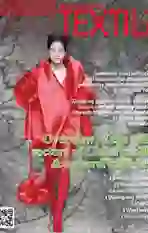Dyeing and printing:Synergistic development of“Technology, Fashion and Green”
2019-02-20
From January 2018 to September 2018, major economic indexes, including the corporate output, operating income and profits, of the dyeing and printing industry all maintained a steady growth. The industrial structure adjustment, transformation and upgrade deepened, and the industrial operation efficiency and quality were favorable. There was an encouraging improvement in the profitability. To be specific, compared with the same period last year, the cloth output of dyeing and printing enterprises above the designated scale reached 35.7 billion meters, increasing by 0.48%. The operating fees, management fees and financial fees accounted for 7.31% of the total expenditure, decreasing y 0.16%. The actualized operating income reached 212.109 billion yuan, rising by 4.42%. The actualized profits totaled at 9.630 billion yuan, which were 7.68% higher than the same period last year. The export delivery value reached 32.070 million yuan, dropping by 2.43%.
From the perspective of industrial layout, high regional concentration was a significant characteristic of the dyeing and printing industry. The southeast coastal areas should continue to play a dominant role in development of Chinas dyeing and printing industry. The regions where the dyeing and printing production capacity concentrated were also the regions with a developed industrial economy in China. In the future, Chinas coastal areas will still dominate in development of Chinas dyeing and printing industry, and the industries with characteristics of Central China and Western China will be properly developed.
As to import and export of eight major categories of printing and dye- ing, 1.042 billion meters were imported, registering a year-on-year decrease of 1.89%, but the growth rate increased by 7.56% compared with the same period in 2016. The import volume reached 1.970 billion USD, registering a year-on-year decrease of 3.79%, but the growth rate was faster than that in 2016 by 7.73%. The average price of import was 1.89 USD per meter, decreasing by 1.94%, but the growth rate was faster than that of 2016 by 0.09%. At present, the export volume of the dyeing and printing industry is rising but the export price is dipping. Therefore, the foreign trade of Chinas dyeing and printing industry will redouble its efforts in accelerating the product structural upgrade, increasing products added-value, and optimizing import and export product structure. Of special note was that the export volume of the eight major dyeing and printing product categories to countries and regions along the “Belt & Road” reached 11.047 billion meters, registering a year-on-year increase of 2.5%; the export volume was 13.038 billion yuan, registering a year-on-year decrease of 2.67%, accounting for 56.80% of the total among the total export volume of the eight printing and dyeing product categories.
At present, affected by inadequate domestic and overseas market demands, trade frictions, growing cost, financing difficulty, growing pressure of energyconservation and emission-reduction, the printing and dyeing enterprises are faced with a growing pressure of cost. Particularly, because of the severe environmental protection situation, the Chinese government hasp promulgated numerous environmental protection policies, including Water Pollution Prevention and Treatment Action Plan, Dyeing and Printing Standards and Conditions, Ecological Environmental Protection and Planning for the “13th Five-Year Program”, Implementation Plan for Control of Pollutant Emission Permit, the Tax Law of the Peoples Republic of China on Environmental Protection, Water Pollution Prevention and Control Planning for Key Drainage Basins(2016 - 2020), Yangtze River Economic Delta Ecological Environmental Protection Planning, have raised a higher requirement of energy conservation and emission reduction of the dyeing and printing industry, and prompted enterprises to further increase their environmental protection input and operation cost. Under the sweeping inspection of environmental protection, the printing and dyeing enterprises in Shandong, Jiangsu and Zhejiang and Henan will be faced with production halt for an overhaul, migration and transformation. The dyeing and printing enterprises will experience a large reshuffling. In the future, the centralized development of dyeing and printing enterprises will be a critically important aspect of the dyeing and printing industrys transformation and upgrade.
To sum up, influenced by the weakening of the domestic demand, emergence of trade protectionism, escalation of Sino-US trade frictions, shift of the overseas market demand and the drop of the demand quantity in 2018, the dyeing and printing cloth output would still maintain a negative growth status. Major economic indexes, including the operating income, profits and so on, would be relatively stable. The overall production and operation status of the dyeing and printing industry would still be severe, making promotion of high-quality development of the industry an urgency.
Over the past few years, development of technology and economy has led to a dramatic change of peoples dressing concepts, with more attention paid to environmental protection, multi-functionality and intelligence. In the future, high-performance and multifunctional fabric market will embrace a growing potential. Besides, the European and American market has an increasingly higher requirement of ecological environmental protection. Some countries excluding Japan, European and North American countries have also attached great importance to ecological safety of products, thus raising a high requirement of dyeing and printing products imported from China. In the future, the dyeing and printing industry should be based on market demands to speed up product transformation and upgrade.
Standing on a new historical starting point, Chen Zhihua, President of China Dyeing and Printing Association, points out that the Association will further strengthen the coordinated governance and cooperation of the industrial chain in 2019; deeply promoting the three-in-one development of “technology, fashion and green”; focus on the industrial cluster service; improve the service quality, and promote the industry accountability manufacturing and green development system. Meanwhile, with the aggravation of the “survival of the fittest”, enterprises must strengthen their competitiveness in adversity; seize the favorable opportunity of industrial reshuffling; build confidence, look into prospects of long-term development, clarify positioning, and pinpoint strategic measures for follow-up development.
